Soundwalks in Chicago Public Parks Activate Communal Listening

Report by Noé Cuéllar, sound artist and MSAE 2025 Summer Soundwalks in the Park Program Director. Edited by Eric Leonardson, sound artist and MSAE President.
The Midwest Society for Acoustic Ecology (MSAE) engages communities in Chicago and across the country. Founded in 2009 as a nonprofit organization, MSAE dedicates itself to understanding the role of sound and listening in natural habitats and human societies. Its mission promotes public dialogue to identify, preserve, and restore natural and cultural sound environments.
Among its varied local and regional initiatives is an annual series of soundwalks in partnership with the Chicago Park District’s annual Nights Out in the Parks (NOITP) arts and culture program. Every year, MSAE invites a selection of artists to create a thematically focused soundwalking experience in a public park, open and free for everyone. Led by artists, but often collaborative, each soundwalk is distinct. Each artist brings their own interpretation to the practice of soundwalking. In the process, they create opportunities for community through group experiences that ground one another throughout the city and its diverse neighborhoods.
Soundwalking emerged in the late 1960s and early 1970s, pioneered by R. Murray Schafer and the World Soundscape Project as a way of exploring the environment through attentive listening. Hildegard Westerkamp described the practice as “any excursion that involves opening our ears to all the sounds in our environment wherever we are.” Since then, artists, researchers, and communities worldwide have adapted and expanded the practice, integrating it into sound art, field recording, urban studies, ecological awareness, and social engagement.
While our ears are always “open,” bringing awareness to the experience of listening itself can further enhance our sense of place, moment, and shared experience. We all listen differently, and when we listen together, we discover new ways of listening.
In 2025, MSAE marked its ninth year of summer soundwalks with NOITP. Between June and September, we offered six soundwalks in six different public parks, guided by nine artists and special guests. Exploring the natural and cultural dimensions of Chicago, set against the city’s numerous overlapping cultural festivals, community gatherings, and tense political climate, the series prompted the question: “How do we attune ourselves to the sounds around us, and where does collective listening lead us?”
Natural and Mediated Outdoor Listening
Longtime collaborators and veteran soundwalk guides Norman W Long and Sara Zalek kicked off the series at Big Marsh Park on Chicago’s southeast side, by Lake Calumet. Norman, a sound artist recently dubbed by the Chicago Reader as “The Natural Listener,” and Sara, a transdisciplinary and movement artist, have explored Big Marsh Park as a site for soundwalks since the beginning of the series in 2017.
Norman and Sara began by greeting a large group of participants, and guiding them through grounding exercises involving breathing, silence, and light movement. Once on the trail, the group walked quietly around the marsh. Multiple “listening stations” were set up along the path: each one with headphones connected for listening to live microphones focused on particular details in the terrestrial environment, in contrast to another set of headphones for listening underwater via hydrophones (underwater microphones). Another was set to listen to the close-up, and otherwise inaudible vibrations of a tree, a plant synthesizer transposed organic material to musical notes. Some soundwalkers also brought their own recording gear, and shared their mediated perspectives with other participants.
This soundwalk gently emphasized contrasts, points of immersion, expansion and contraction, natural listening and mediated listening, “Marsh Melodies and the Breathing Ear.” Sara and Norman write, “As a silent mass, diverse and in solidarity, we listen out for and to the layers of sounds most often tuned out or discounted, points of unity, resonance, dissonance, and divergent noises. Our walk includes meditation practice, ear calibration exercises, interactive recording demonstrations, and performance.”
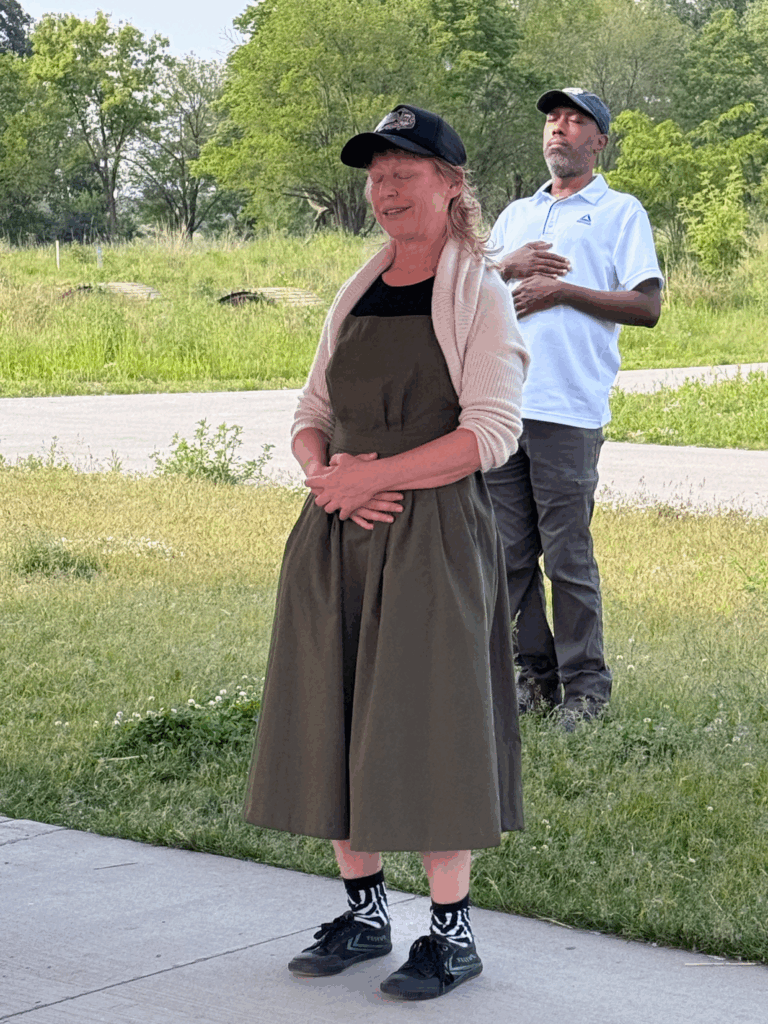

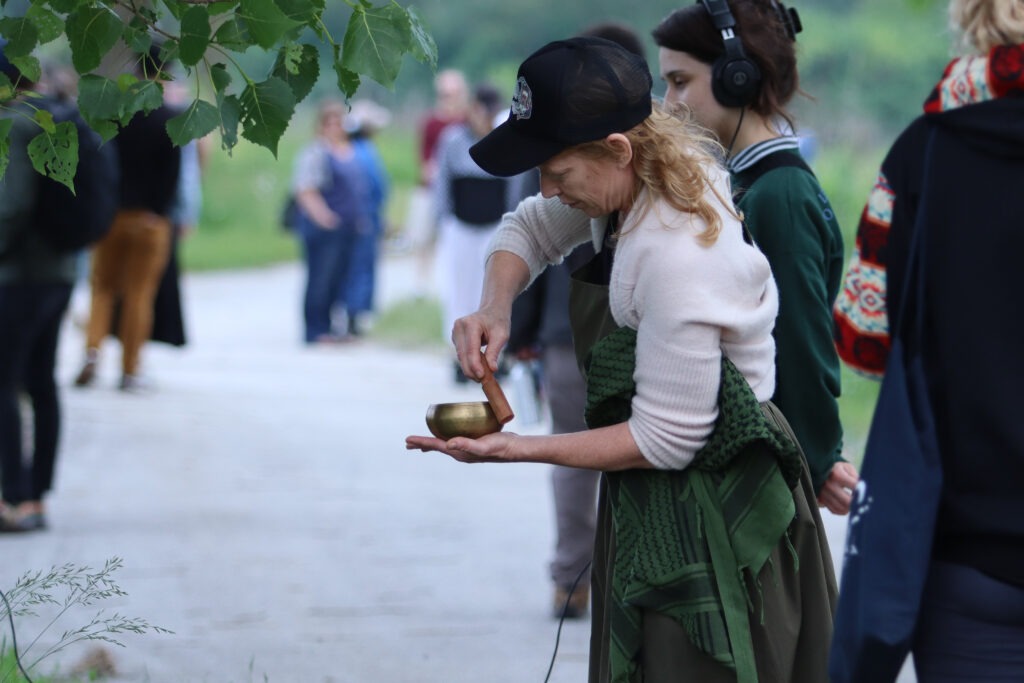


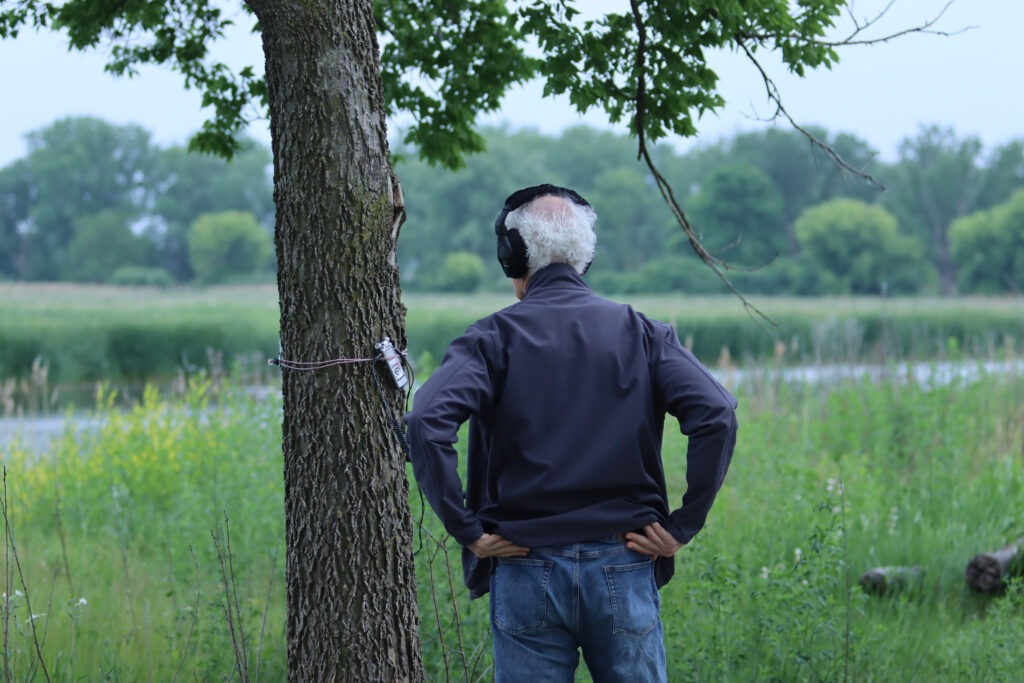

Images courtesy of Daniel Tseng and Noé Cuéllar
Drifting and Connected Listening
In Palmer Square, interdisciplinary sound artist and youth mentor Allen Moore hosted a “Sonic Drifting through the Square.” Keeping guidelines at the bare minimum, Allen created an experience of drifting with little to no plan to open up possibilities along the way. He simply guided the group to follow a particular path, creating a circle around the park, along which multiple stops were made to slow things down, to listen to people’s activities, nearby traffic, and the trees.
During the walk, Allen pointed out how some trees were planted by a fellow neighbor in Palmer Square, as part of a plan to revitalize the species. Allen writes, “The elm trees of Palmer Square were attacked by Dutch Elm Disease and in 1979, the city cut down most of the trees due to the disease. Palmer lost the majority of the elm trees before hybrid trees were introduced and maintained by a man named Steve Hier, and neighbors, who put together their own money to have them treated every 3 years.”
To everyone’s surprise, Steve Hier happened to walk by and asked what the group was doing. When they realized he was the very person Allen had just mentioned, Steve joined in and shared stories about his long-standing involvement in the park’s community life. Such a serendipitous encounter emerged from drifting, listening, connecting, and simply being in the moment.
Palmer Square’s dedication to its trees continues to be recognized more broadly. In 2024, the park received ArbNet Level I accreditation from the Morton Arboretum, acknowledging the Chicago Park District’s commitment to sustaining and expanding the urban forest canopy. The announcement can be read on the Chicago Park District website.
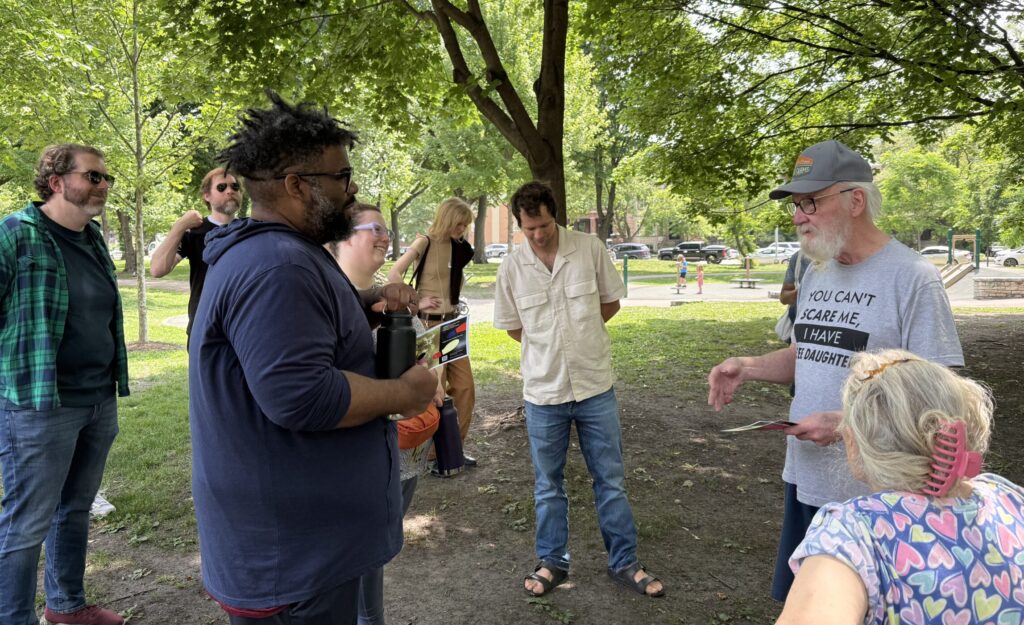
Transmissions and Extended Listening
Sound artist Veronica Anne Salinas invited sound artist Amanda Gutiérrez to collaborate on their soundwalk “Walking as an Infra-Antenna” at West Ridge Nature Park. The title refers to the artists’ use of radio as “a symbolic tool of spectral communication to connect with the living and the dead, crossing borders, time zones, and metaphysical dimensions.” Veronica and Amanda shared FM radios with the group, who tuned the dial to a recorded transmission—or as described by the artists, a “sound incantation”—nearby.
The artists write, “FM incantations act as a metaphor for enacting magic technology, emitting radio transmissions and receiving electromagnetic waves from/to the infraworld, future entities, and past ancestors through resonant signals. Sound is translated through the radio as a ceremonial practice for communal listening, with our bodies as antennas to the sacred airwaves.”
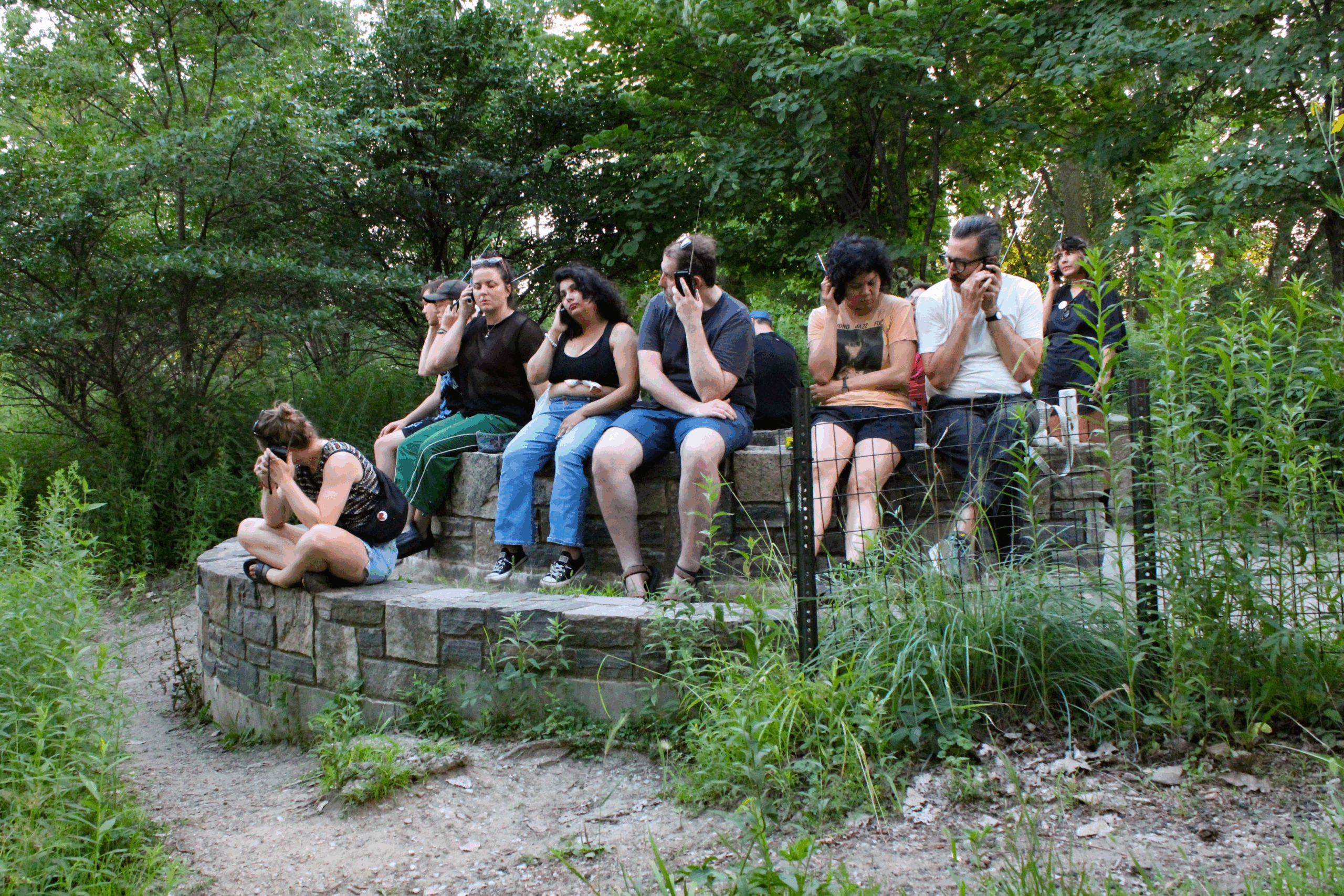
Prompted Listening and Music Sharing
Media artist, writer, and educator Josh Rios joined MSAE’s soundwalk series for a second year. This year, he presented “Pass the Aux: A Collective Sharing and Listening Session,” engaging a group to listen not through walking, but site-specifically at a specific point in the park. Gathered on the grass, Josh prompted everyone to ponder their music listening habits and pick a song to share. Then, he “passed the aux” to everyone to listen to each song together.
Each participant introduced their chosen song by sharing a personal story or memory attached to it. One by one, they streamed, Bluetooth-connected, and multi-adapter-linked their various devices to a shared boombox. Together, the group listened closely, noticing patterns and emotional resonances that emerged across the selections. Conversations unfolded around these connections—the rare joy and vulnerability of listening to music collectively, especially among strangers. Many expressed a wish to make such experiences more common, even proposing the creation of shared playlists based on recurring themes, such as longing.
For the occasion, Josh distributed handmade pamphlets with reflective prompts, inviting participants to write responses.
The collective playlist that emerged during this session included:
- Arthur Russell – Wonder Boy (1970s)
- Monster High – Coming Out of the Dark (Reprise) (2022)
- Flaco Jiménez – Soy de Texas
- José Luis Perales – ¿Y cómo es él? (1982)
- Valerie June – Joy, Joy! (2025)
- Paul Simon – American Tune (1973)
- Cameron Winter – Love Takes Miles (2024)
- The Voidz – Human Sadness (2014)
- The Jazz Crusaders – Way Back Home (1969)
- The Carpenters – Love Me for What I Am (1975)
- Joni Mitchell – California (1971)
- The Fall – Quit iPhone (2015)
- Triumphs – Burnt Biscuits (1961)
Varying widely in style, each song reflects an equally wide variety of listeners and their motivations: spontaneity, belonging, nostalgia, pets, aesthetics, politics, family, and childhood memories. What song would you have chosen, or which would you add to the playlist? Try this at home!

Co-creating a Listening Body
The Columbus Park Refectory in Austin near Oak Park is a mysterious place for many. It is primarily open for rentals, and often closed to the public. Deirdre Harrison and guest Katie Mazzini grounded their “Tune In, Take Turns” soundwalk at the Refectory, and extended out to the park. They contrasted the outdoor listening experience with that of the Refectory’s reverberant interior. They started off by getting in a circle, inviting everyone to relax and make a silly vocal noise that got passed between each of them around the circle. Once loosened up, the group headed outdoors to create new circles, sensory openings to the environment, and vocalizations.
Back at the Refectory, the group got in a circle again, this time to perform experimental composer and Deep Listening pioneer Pauline Oliveros’ EcoChoir, a simple text instruction-based composition for a group of voices. Deirdre has done a little bit of everything, from acting on international stages to leading arts and education nonprofits in Chicago, and Katie is a theatre artist who has created original shows around the world, and who often develops projects with other artists while training with her mentor, Fides Krucker. Deirdre and Katie love bringing people together through music and theater, and their soundwalk brought awareness to the collective listening body that is ephemera as it is transformative.
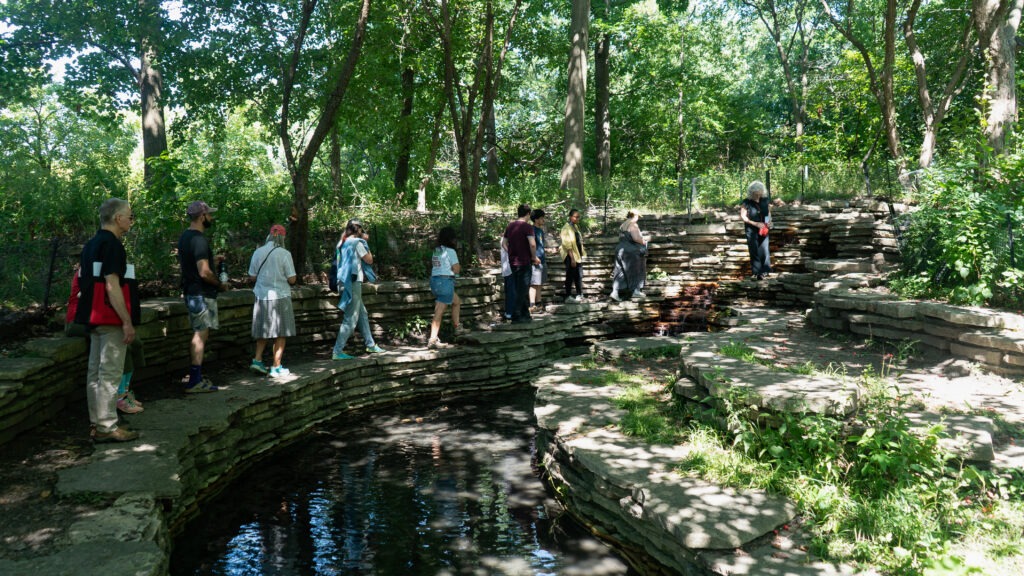

Group performance of Pauline Oliveros’ EcoChoir at the Refectory in Columbus Park. Image courtesy of Daniel Tseng
Singing Insects on a Listening Island
Co-founder and President of the MSAE Eric Leonardson has collaborated with various special guests for his soundwalks. This year, he returned with Negin Almassi, a local naturalist who teaches people how to identify insects by their song for the Singing Insects Monitoring Program, a community science effort involving recording songs of insects. During the walk, a large group of listeners gathered at Jackson Park, where parties in the parking lot filled the area with dance music. As we walked toward the Wooded Island past the bridge, the acoustic horizon widened, bringing into focus the subtle sounds of evening katydids and crickets. Negin helped us identify their various sounds and taught us how their location on the island correlates with the particular vegetation that they interact with. This served as an experiential reminder of the different listening and sounding entities that surround and inhabit the city along with us.
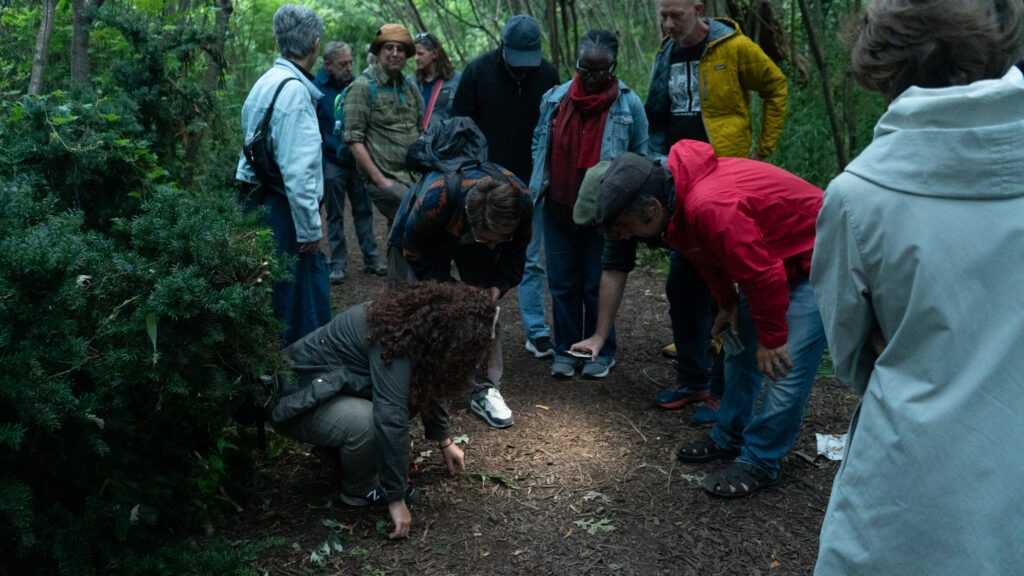
The MSAE is honored to rediscover the acoustic dimensions of Chicago alongside artists through this year’s soundwalk series. We’ve experienced depth and joy in finding ourselves in communities of listeners. We encourage ongoing connection among us as we carry on listening to our surroundings throughout the year.
Everyone is invited to become a member of the MSAE. MSAE members are part of a growing community who listen, study, learn, share, create, publish, partner, collaborate, and lead our understanding of acoustic ecology. Annual membership dues support our programs and the people who make them possible, and comprise our main source of programmatic funding. Members may receive access to the members’ directory, discounts for special events, services, tools, and publishing opportunities. Click here for more information, and keep in touch!


